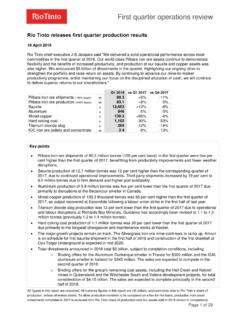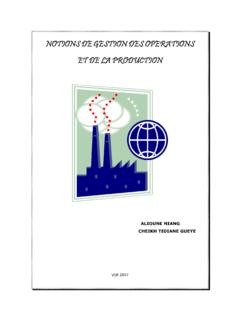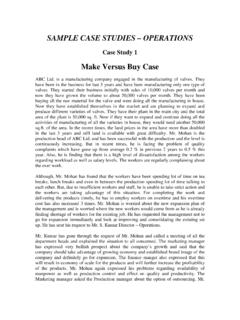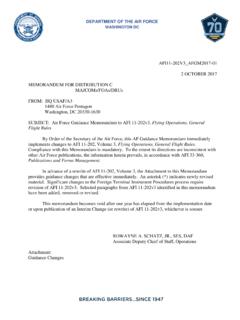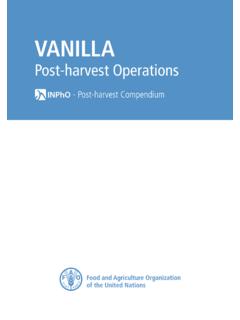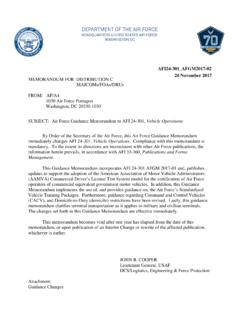Transcription of INSECT DAMAGE - Food and Agriculture Organization
1 INSECT DAMAGEPost-harvest operations - Post-harvest CompendiumINSECT DAMAGE : DAMAGE on Post-harvest Organisation: International Centre of INSECT Physiology and Ecology (ICIPE) ( ) Author: Mohamed N. Sallam Edited by: AGSI/FAO: Danilo Mejia (Technical), Beverly Lewis (Language&Style) Contents 1. Introduction .. 2 Magnitude of the problem .. 4 Storage and Losses .. 5 INSECT 8 2. Major INSECT pests of stored foods .. 10 Coleoptera .. 10 Lepidoptera .. 19 Fungal contamination and production of mycotoxins .. 22 3. References .. 26 INSECTS: Post-harvest operations Page 2 1. Introduction Insects are the most diverse species of animals living on earth. Apart from the open ocean, insects can be found in all habitats; swamps, jungles, deserts, even in highly harsh environments such as pools of crude petroleum (Imms, 1964). Insects are undoubtedly the most adaptable form of life as their total numbers far exceed that of any other animal category.
2 The majority of insects are directly important to humans and the environment. For example, several INSECT species are predators or parasitoids on other harmful pests, others are pollinators, decomposers of organic matter or producers of valuable products such as honey or silk. Some can be used to produce pharmacologically active compounds such as venoms or antibodies. Less than percentage of the total number of the known INSECT species are considered pests, and only a few of these can be a serious menace to people. INSECT pests inflict DAMAGE to humans, farm animals and crops. INSECT pests have been defined by Williams (1947) as any INSECT in the wrong place. Depending on the structure of the ecosystem in a given area and man's view point, a certain INSECT might or might not be considered a pest. Some insects can constitute a major threat to entire countries or a group of nations.
3 One prominent example is the tsetse fly that puts about 100 million people and 60 million head of cattle at risk in sub-Saharan Africa due to the transmission of trypanosomiasis (ICIPE, 1997). Herbivorous insects are said to be responsible for destroying one fifth of the world's total crop production annually. One major reason why there are pests is the creation of man-manipulated habitats, that is, agroecosystems that fulfil man's needs, where crops are selected for their large size, high yield, nutritious value, and clustered in a confined area. This does not only satisfy man's demand, but provides a highly conducive environment for herbivorous insects at the same time. In the process of artificially selecting suitable crops for human consumption, highly susceptible plants for infestation by insects are also selected. Many of the crop varieties that were developed during the past 30 years produced high yields, but, they also had poor storage characteristics (Kerin, 1994).
4 INSECT pests are capable of evolving to biotypes that can adapt to new situations, for example, overcome the effect of toxic materials or bypass natural or artificial plant resistant, which further confounds the problem (Roush and McKenzie, 1987). Provision of food has always been a challenge facing mankind. A major cornerstone in this challenge is the competition from INSECT pests. Particularly in the tropics and sub-tropics, where the climate provides a highly favourable environment for a wide range of insects, massive efforts are required to suppress population densities of the different pests in order to achieve an adequate supply of food. In the developing countries, the problem of competition from INSECT pests is further complicated with a rapid annual increase in the human population ( percentage) in comparison to a percentage increase in food production. Taking into consideration sudden problems caused by drought in places such as Africa, considerable losses of agricultural products add a serious burden to people's daily life.
5 The introduction of alien pests into new habitats due to the global increase of trade and transport causes another dilemma. When a pest is carried to a new geographical area, its natural enemies that keep it in check in its aboriginal home are normally left behind. This situation, in most cases, may lead to critical complications. One major example is the introduction of the spotted stemborer, Chilo partellus Swinhoe, into Africa coming from Asia early this century, that is now responsible for significant losses in maize and sorghum in many parts of Eastern and Southern Africa. The exotic pest may have also led to partial displacement of the native African stemborers such as Sesamia calamistis Hampson, Chilo orichalcociliellus Strand and Busseola fusca (Fuller) (Overholt et al., 1994; Kfir, 1997). Recent estimates of yield losses due to stemborers alone in sub-Saharan Africa are in the INSECTS: Post-harvest operations Page 3 neighbourhood of 20-40 percentage of the potential yield (Youdeowei, 1989; Seshu Reddy and Walker, 1990).
6 These losses indicate the importance of stemborers as a limiting factor affecting crop productivity in Africa. Prostephanus truncatus (Horn) is another exotic storage pest native to Mexico. It has recently been introduced to Africa (McFarlane, 1988; Pike et al., 1992), where it is currently a more destructive pest of stored maize and cassava than in its native Central America (Dick, 1988). P. truncatus attacks maize before and after harvest. Adults bore into the maize cob causing severe DAMAGE and weight loss. In Tanzania, maize losses of up to 35 percentage may occur due to P. truncatus in 5-6 months if improperly stored (Mallya, 1992), and up to 60 percentage after nine months of storage (Keil, 1988); a situation that may result in a serious famine. Subsistence grain production is essential for the growing population of Africa. Maize is the main staple food in sub-Saharan Africa.
7 An area of million hectares is planted to maize in the whole of the African continent, with an average annual production of 29 million tons (Christopher et al., 1996). In sub-Saharan Africa, three quarters of the total production of maize is consumed as human food, which is also the case with other cereals such as sorghum and millet. The area planted by sorghum in Africa accounts for million hectares with an average yield of ton/ha, while million hectares are planted with different types of millet (finger millet, pearl millet, presom and foxtail millet), yielding an annual average of ton/ha (FAO & ICRISAT, 1996). Several factors are responsible for this considerably low level of production, of which INSECT pests are chiefly involved. In the Kenyan highlands, total losses due to pests in maize were estimated at 57 percentage, with INSECT pests being more important than diseases (Grisley, 1997).
8 In Zimbabwe, grain DAMAGE of 92 percentage in stored maize was reported due to INSECT pests. Treatment with malathion reduced the DAMAGE by only 10 percentage (Mutiro et al., 1992). In Namibia, up to 30 percentage losses in pearl millet production can take place due to the bush cricket, Acanthopolus discoidalis (Wohlleber et al., 1996). Root crops, such as cassava and potatoes, and pulses, which are legumes grown for their edible seeds, provide the basic source of carbohydrates and protein for people in many parts of the African continent. The area planted to cassava in sub-Saharan Africa is estimated to be million hectare producing 72 million tons annually (Sengooba, 1994). INSECT pests, in addition to fungal diseases, are responsible for 50 percentage DAMAGE in cassava (Yaninek,1994). Pulses, described as the poor man's food (Aykroyd & Doughty, 1982), are widely planted in west Africa.
9 Cowpea, for example, is grown extensively for seeds, pods and leaves in about 15 African countries, among which Nigeria and Niger produce half of the world's total crop (Pandey & Westphal, 1989). Cowpeas are attacked by a complex of INSECT pests, particularly towards the end of the planting season. In storage, the bruchid, Callosobruchus maculatus, causes the major losses. Infestations of stored cowpeas can be as high as 90 percentage in markets and in village stores (Alebeek, 1996). Almost 80 percentage of these food crops are produced by small scale farmers and stored on the farm (Wongo, 1996). Due to poor storage structures and conditions, severe losses in quality and quantity of stored food are inflicted annually. Quantitative assessment of losses is difficult because of the high variability in infestation from year to year, however, estimates from several countries in Africa indicate an intense impact of INSECT pests (see table 1).
10 In Kenya, the National Food Policy Document reported up to 30 percentage destruction of harvested maize due to pests during storage and handling (Wongo, 1996). In West Africa, up to 100 percentage DAMAGE to cowpeas may happen in a few months after storage due to the infestation of C. maculatus (Lienard & Seck, 1994). Such high levels of losses continue to take place because of poor threshing, cleaning, drying and storing techniques. INSECTS: Post-harvest operations Page 4 Magnitude of the problem After the crop is harvested, it undergoes several operations that, if improperly done, may result in serious losses (see Laubscher & Cairns, 1983; Giga, 1987; Jonsson & Kashweka, 1987; Gwinner et al., 1996). As a start, it should always be recognised that an intact grain is an essential item for successful storing. Cracked or broken grains provide an entry point for infestation by insects and moulds during storage.












